Hideaki Annos Greatest(?) Work
I started along the path of an odd thought process the other day. It started when someone brought up Trava – Fist Planet in the context of being a same universe relative of the spectacular looking new movie REDLINE. This, obviously, got me thinking somewhat about Trava – Fist Planet.
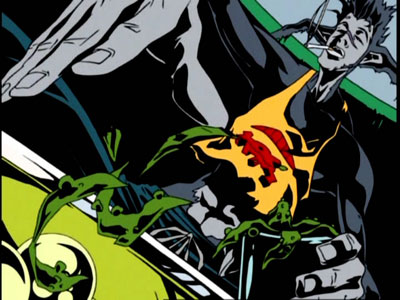
You’d be forgiven for not knowing anything about Trava for a couple of reasons. Firstly, it’s kind of old at this point. Well, old in anime terms, which in reality means it was made in 2003, which was before much of the internet was particularly interested in looking for anything quite as offbeat as the Madhouse production was. More than the age, though, the way it was distributed no doubt hampered its following. Trava was originally serialised as part of Grasshoppa!, a DVD magazine almost like an audio-visual Faust, featuring live action and animated shorts both serialised and one-off. The best known content that debuted on Grasshoppa! is probably Studio 4°C’s Sweat Punch shorts, including End of the World and Comedy, that were later released under the name Deep Imagination.
The sad thing is that, when I finally decided that I’d kind of like to see the Grasshoppa! disks, they were extremely out-of-print, doubly so the DVD which collected the Trava episodes which had been spread throughout into one convenient package. Ultimately, of the four volumes of the series released, I ended up with only the third, and let me tell you, for something as thoroughly peculiar as Trava, the third instalment really isn’t a good place to start. It was kind of impenetrable, infact.
This is, of course, all a massive digression, as Trava, from REDLINE staffers Takeshi Koike and Katsuhito Ishii, has nothing to do with Hideaki Anno. Further along the path this line of thought had taken me, however, was the remembrance that the third instalment of Grasshoppa! also included things which weren’t related to Fists or Planets. Things like Ryusei Kacho, by a certain guest director recognisable to many a fan merely from his favoured choice of typeface.
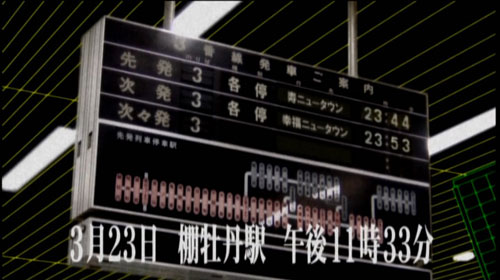
The thing about Ryusei Kacho which is leading me to post is that, curiously, it’s missing from many of Hideaki Annos filmographies. Not all of them, but it is mysterious in it’s absence from most of the ones which matter – at the time of writing, Wikipedia, ANN nor even IMDB make mention of it at all, and yet it’s something that certainly exists. It’s kind of sad, really.
Thankfully, Ryusei Kacho is also one of those works which is kind of hard to truly spoil – sure, I can detail all which it contains, but it’s something which, as insane as someone can make it sound, you’ll still be ill prepared to actually experience yourself. This is just as well, as I feel I need to try and do my damnedest to incite people to try and track the thing down.
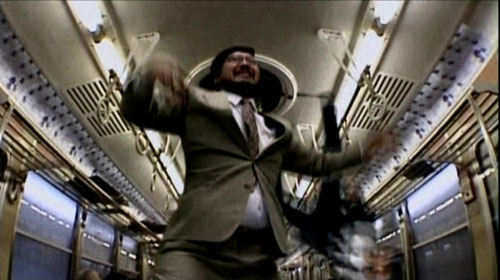
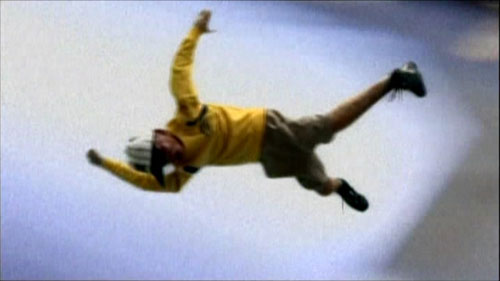
In the universe of Ryusei Kacho, which I’d like to believe is entirely true to real life, the fiercest battlefield of them all is the Japanese commuter train. Every day is a titanic, terrifying battle for something even more important than mere life or death – the chance to sit down. Throughout all the chaos, bloodshed and, err, child-flinging, one middle-manager has survived to attain near mythical status. He is known as Ryusei Kacho, and he always gets a seat.
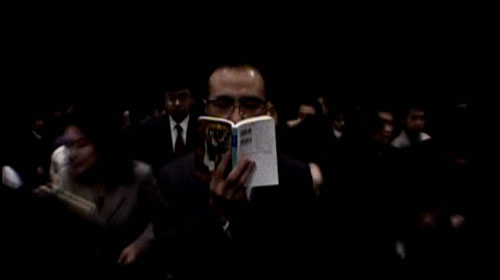
Yet, Kacho is not the only one proficient in obtaining a comfortable ride home, for he meets his match in the form of Maria, who incites people to make room for her by waggling her leather-skirted backside in their faces. What’s worse is that Maria recognises Kacho as being the true identity of the underground glam-rock legend Marilyn Denjiro. Formerly being a huge fan of the now-defunct singer, Maria attempts to convince Kacho to return to music, but he feigns ignorance on the matter.
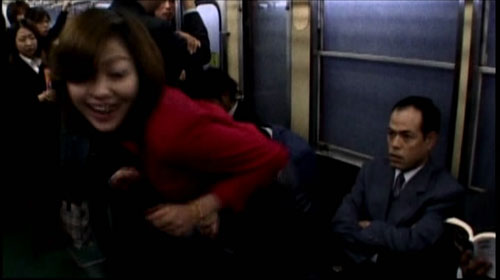
This leads Maria to challenge Kacho to a battle in his own game right on his own turf – if she can secure seating even where Kacho cannot, then he must perform her favourite song. Thus begins the epic final battle, climaxing with Kacho pile-drivering Maria from orbit, complete with some of the most intentionally terrible CGI you are ever likely to see.
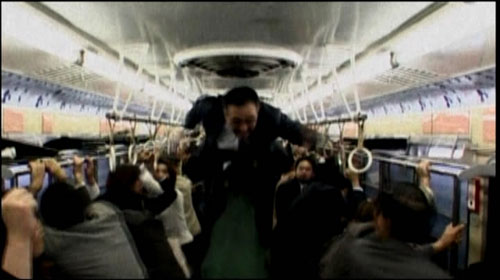
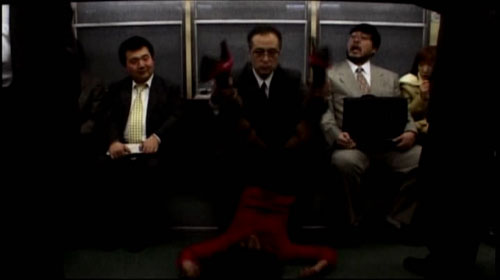
Truthfully, Ryusei Kacho, as brilliantly insane as it is, is too insubstantial to really be great. It’s certainly both astonishing and amazing, but the only ground it really breaks is that upon which Anno’s later Cutie Honey adaptation was later built. Kacho utilises a lot of the kind of effects, like the peculiar looking live-action stop-motion techniques, that he went on to use with such relish in that later movie. I’m sure a much of that had it’s basis in his earlier amateur effects-movie works, but it’s easy to see this production as a testing ground for the techniques he was intending to use in Honey.
At just fourteen minutes long, though, it’s really hard to complain about something as wildly entertaining as Ryusei Kacho being a waste of time for being too light-weight. It’s different enough from everything else that Anno has put out that it’s totally worth at least a look for anyone with an interest in him as a director, and it’s a bemusingly surreal piece for anyone who isn’t.
